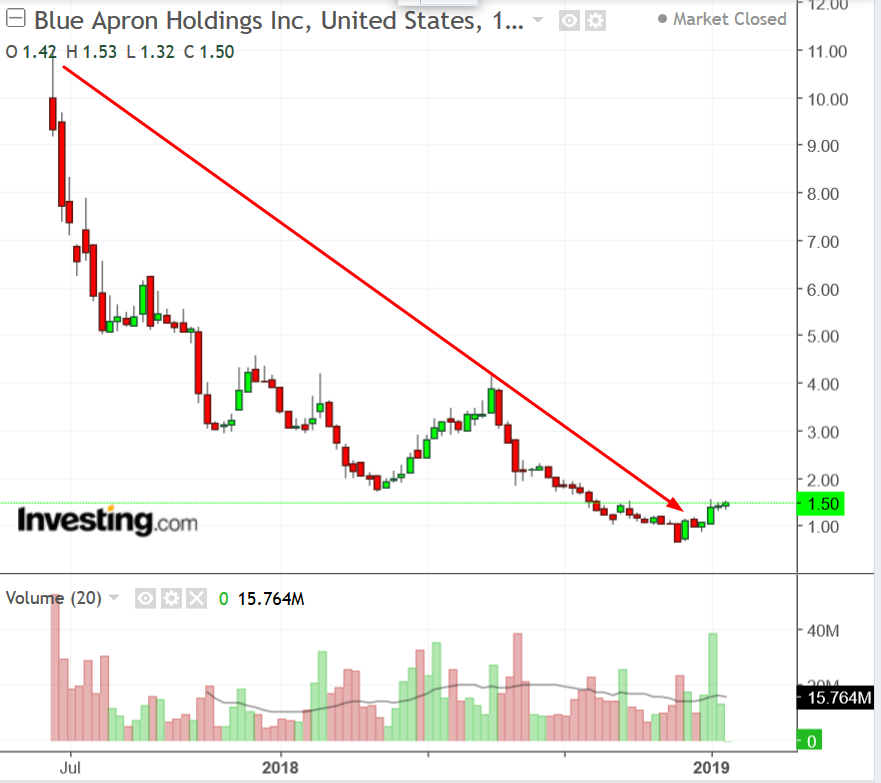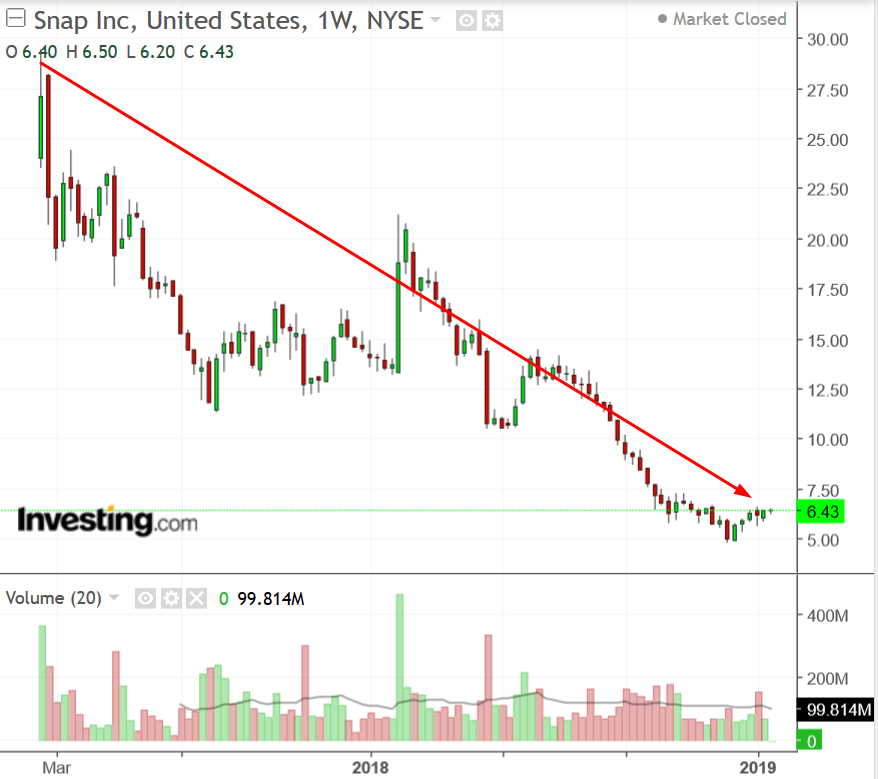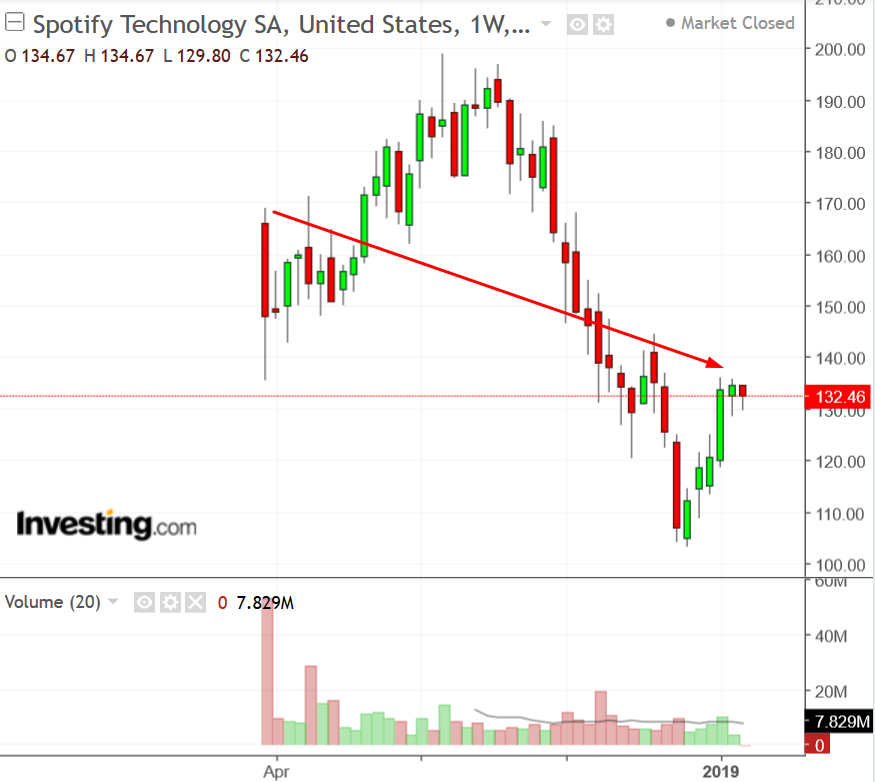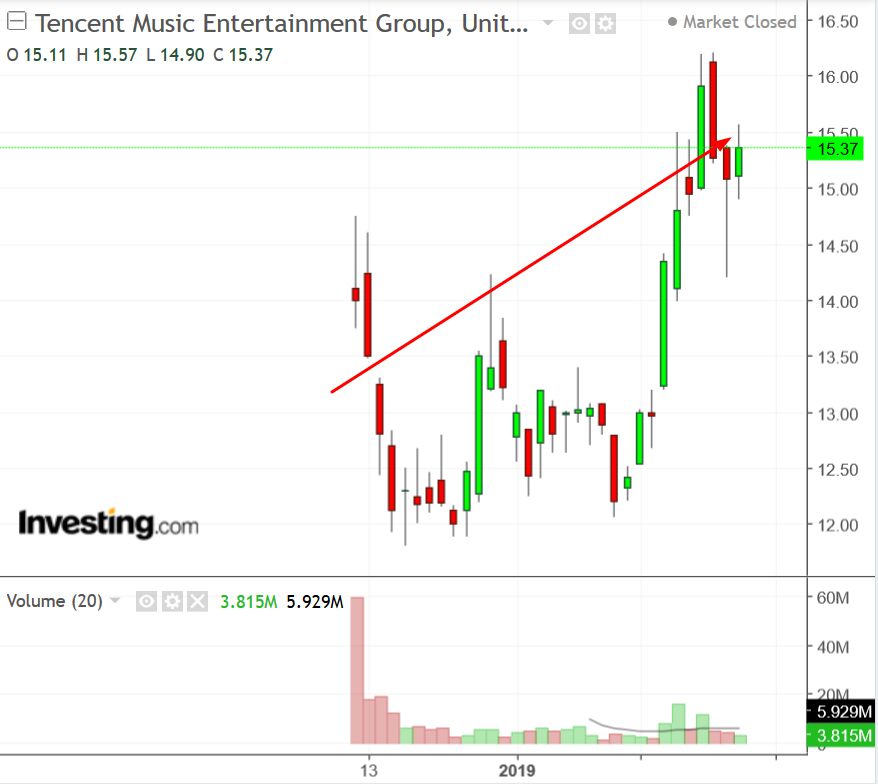The environment for Initial public offerings (IPOs) was robust last year. According to a recent report from Renaissance Capital, 190 companies—almost 20% more than 2017 and the most since 2014—went public in 2018.
Some 81% of those companies priced in or above their indicated range—the most in over a decade. But as the broader market slipped as the year wound down, the luster of these new stocks dimmed. In the aggregate, the 2018 class of initial public offerings returned -2.3%, versus the five-year average return of 20%.
Indeed, younger companies have been hit the hardest as investors question how well they'll be able to hold up if the economy slows and some businesses are forced to deal with a downturn for the first time in their history.
Below, in no particular order, are four of the most recent high-profile IPOs. Each has failed to live up to expectations since going public.
1. Blue Apron
Meal-kit service Blue Apron Holdings (NYSE:APRN) has had a rough time since it went public during June 2017. The stock has dropped by a whopping 84%, as the company struggled to keep its subscriber numbers up in a crowded field of meal kit options that includes offerings from Amazon (NASDAQ:AMZN), HelloFresh (DE:HFGG) and Chef'd, which is owned by privately held True Food Innovations.
The company's stock, which closed yesterday at $1.50, currently has a market cap of $290 million and had recently been trading below $1. At one point in late December, shares fell to as low as 65 cents.
Since that nadir the stock has more than doubled, thanks to a 45% surge on January 15 after the company affirmed guidance for its most recent fiscal quarter. It also said that it plans to reaffirm its confidence regarding being profitable during both the first quarter of 2019 and the full fiscal year.

To help lagging sales, Blue Apron has signed a number of partnerships. Last month, it launched a collaboration with WW (NASDAQ:WTW), formerly known as Weight Watchers, to bring healthy meals to consumers. The company has also partnered with Jet.com, which is owned by Walmart (NYSE:WMT), to deliver its meals across New York City.
Blue Apron also teased that it would share more innovations during its earnings call on Thursday, including a new offering for brick-and-mortar stores. Blue Apron is due to report fourth-quarter results on January 31 before the market open. Consensus calls for EPS of -$0.17 on Revenue of $139.86M.
2. Snap
Snap (NYSE:SNAP) has become a poster child for what can happen when an IPO goes wrong. Shares of the social media company, which once was seen as a potential spoiler for Facebook (NASDAQ:FB), continue to trade near their all-time lows. The stock closed yesterday at $6.43, off 62% from the IPO price of $17 in March of 2017, and down 78% from a post-IPO high of nearly $30 per share.

Snap's stock has swooned as the company faces fierce competition from Facebook-owned Instagram, which co-opted Snapchat's Stories feature. While Instagram dethroned Snapchat as most popular platform among teenagers in 2018, the past 12 months have also been tough for the social media company amid the departure of notable executives.
Most recently, Elizabeth Herbst-Brady, Snap's head of global strategic partnerships decided to leave the company after two years. Her departure follows Imran Khan, formerly chief strategy officer, Drew Vollero who was chief financial officer, Jeff Lucas as head of sales, and others.
Still, some analysts are hopeful that the expected redesign of Snapchat's Android app may attract new users in countries with a smaller proportion of Apple (NASDAQ:AAPL) iOS users. That remains to be seen, perhaps via Snap's next report. It's scheduled to release fourth-quarter earnings on February 5, after the close. Consensus calls for EPS of -$0.08 on $376.64 of revenue.
3. Spotify
Shares of Spotify (NYSE:SPOT), which closed yesterday at $132.46, have moved higher since the year began, gaining around 17% so far in 2019. However, despite the uptick, the streaming music company is still around 20% below its April 2018 IPO price of $165.90.
After the stock flirted with $200 over the summer, Spotify tumbled to an all-time low of $103.29 on December 24. It has since bounced back to its current $132-level.

Spotify opted to cut out much of the traditional role that Wall Street played in the IPO when it went public. The company essentially posted available shares on the New York Stock Exchange and let the market figure out a fair price, rather than selling a certain number of shares to Wall Street kingpins before the general public could buy them.
This allowed Spotify management to profit more handsomely from the offering. However it also means the stock doesn’t have the downside protection that traditionally comes from a traditional IPO, making it more vulnerable to sudden downward swings. Traditional IPOs are usually led by investment banks, known as "underwriters," who can step in to stabilize trading by purchasing or selling shares in times of market turmoil.
Worries that Spotify was losing market share to its chief rival Apple Music (NASDAQ:AAPL) and that its international expansion initiatives weren’t going smoothly, certainly haven't helped either. Spotify is expected to post fourth-quarter financial results on February 6, before the U.S. market opens. Consensus calls for EPS of -$0.19 on revenue of $1.70 billion.
4. Tencent Music Entertainment
Last month's debut of Tencent Music Entertainment Group (NYSE:TME), a spinoff of China messaging and gaming giant Tencent Holdings (OTC:TCEHY), illustrates the lack of investor demand for Chinese IPOs.
The stock, which IPO'd at the bottom of its price range, at $13 per share on December 11, dropped to a low of $11.88 on December 24. It's currently trading just above the IPO price at $15.37.

The music-streaming firm will release its fourth-quarter earnings on February 27. For its third quarter, the company reported earnings of 9 cents per share, up 100% from the year-ago period. That was the seventh quarter in a row of triple-digit gains. Revenue rose 65% to $723.9 million.
Investors will be eager to see if Tencent Music can continue delivering double- and triple-digit revenue growth, as it has done over the past seven quarters. In addition to those top- and bottom-line numbers, market players will also be scrutinizing the company's user growth. According to the most recent company filing, the Chinese streaming music giant has over 800 million monthly active users.
